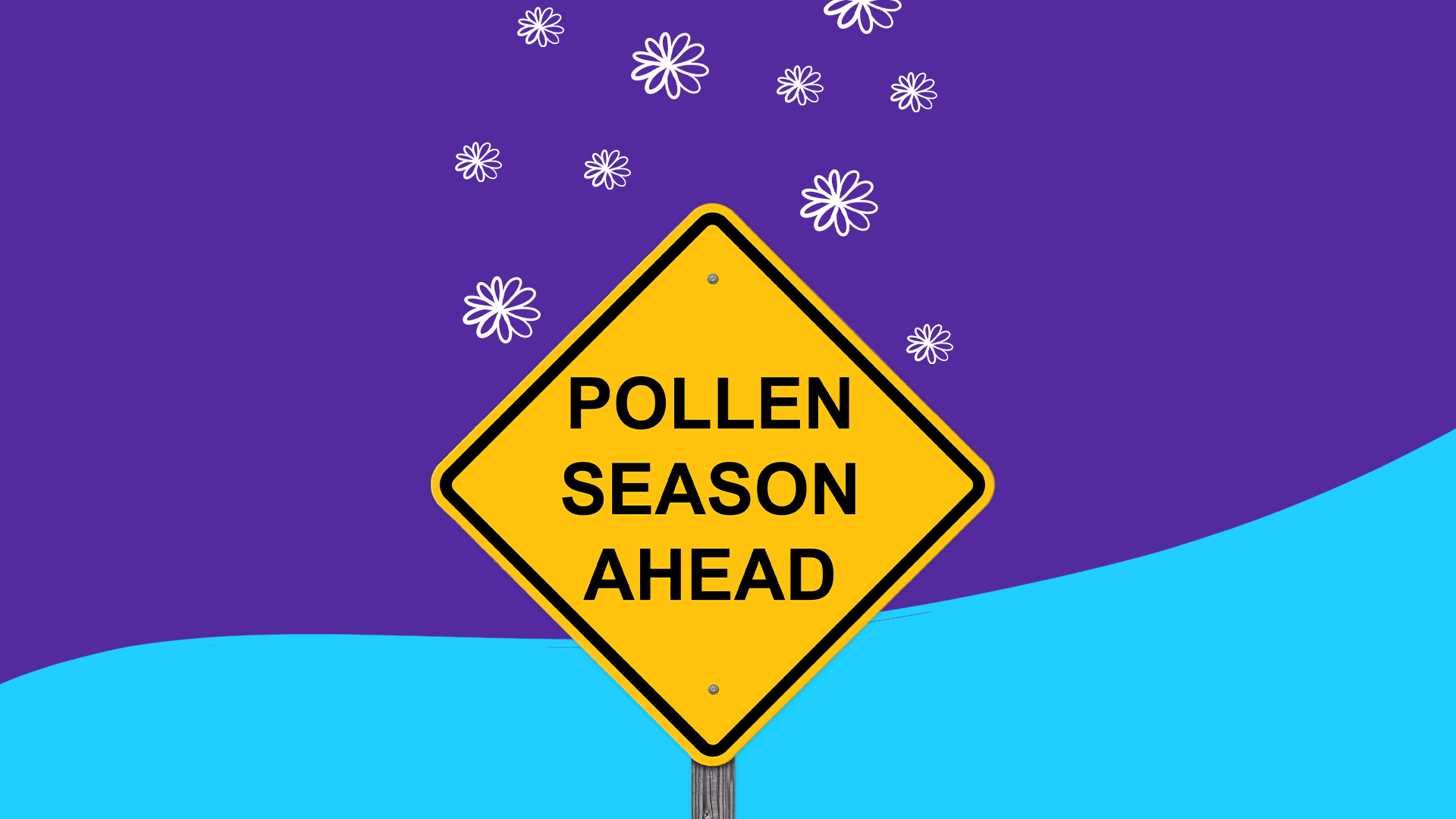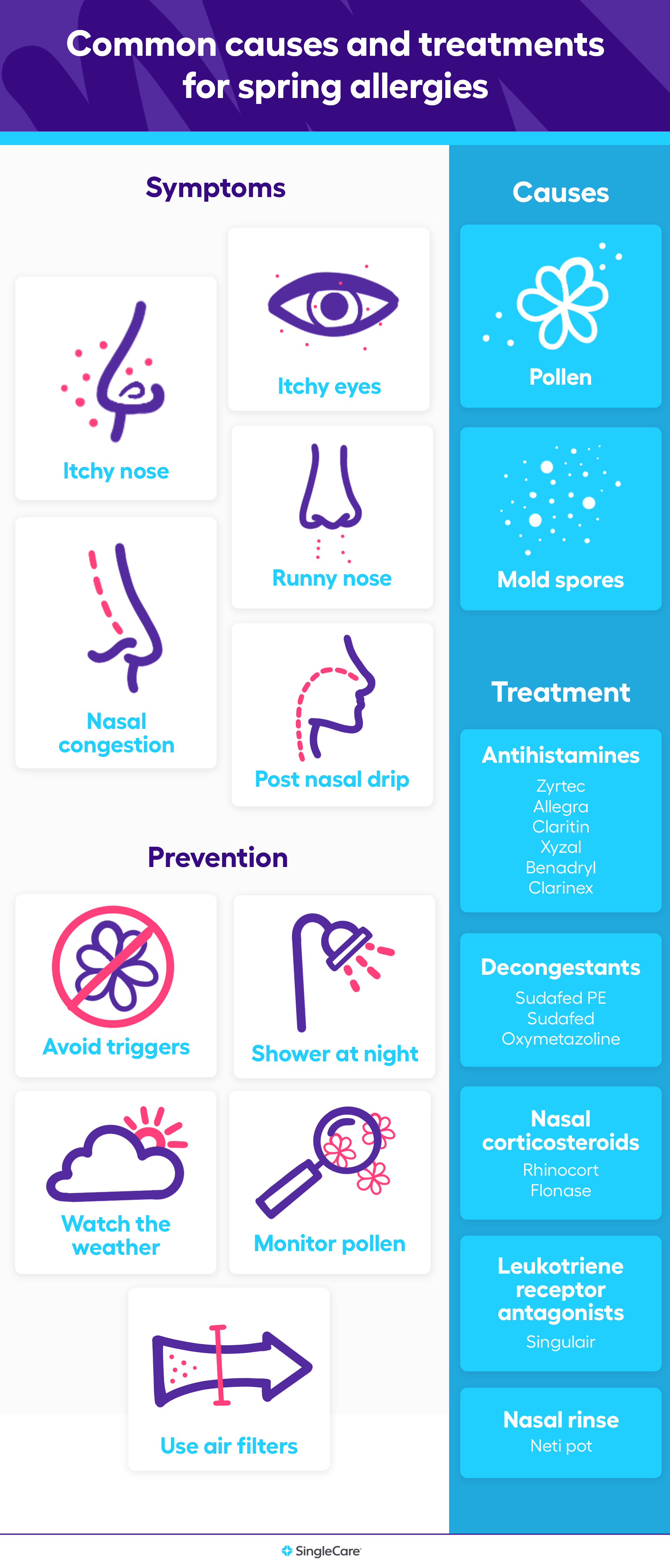Spring allergies: If just seeing those two words makes your eyes water, you likely have experience with this common annual problem. At least 20 million adults and 6 million children live with allergic rhinitis, otherwise known as hay fever, according to the Asthma and Allergy Foundation of America (AAFA).
Although sniffling and sneezing isn’t limited to the spring, symptoms can start as the first flowers start to bloom (and last through the fall—depending on what you’re allergic to). In the northeast, April showers bring May flowers. But, in many parts of the U.S., spring allergy season can start as early as February when pollen starts to circulate , sticking around through summer.
What causes spring allergies?
According to the American Academy of Allergy, Asthma & Immunology (AAAAI), the most common spring allergy causes are:
- Pollen
- Mold spores
Pollen allergies were the most common type of allergy reported by survey respondents in SingleCare’s allergy survey. Mold allergies were the third most common type of allergy reported.
Tree pollination usually begins first, and then the grass pollen follows later in the spring. Since moisture helps mold develop, a rainier spring will result in more spores. Some people may be only allergic to one thing, but many are allergic to more than one.
There are regional variations in the pollen that cause the worst symptoms. Take Texas, for example, which is known for its cedar fever. “Cedar, yellow pine, and ragweed are the most common seasonal pollen spring allergies in the Houston area,” says Ben Cilento, MD, an otolaryngologist and sinus surgeon with Texas Sinus & Snoring.
Meanwhile, to the north in Ohio, tree pollen is also the big culprit for spring allergies, but it’s different trees causing the symptoms, says Summit Shah, MD, an allergist with Premier Allergy & Asthma. “Birch, maple and oak are the worst ones for Ohio, and some sycamore and hickory,” he says.
Though, it’s not just the trees in your own yard that are to blame. That’s because pollen seeds are tiny and lightweight. “They travel for miles and miles, sometimes up to 100 miles away,” says Dr. Shah.
Symptoms
You might not be able to really enjoy the daffodils poking their heads out of the ground or the pale green buds on the trees when you’re dreading the symptoms they may bring. For people with spring allergies, the beauty of the great outdoors can bring the following reactions:
- Itchy nose
- Watery eyes
- Itchy eyes
- Nasal congestion
- Runny nose
- Postnasal drip
If you experience these telltale signs each allergy season, consider making a plan to tackle spring allergy symptoms with your healthcare provider.
Prevention
Prevention is a good first step toward coping with a spring allergy. Start with these strategies.
Avoid allergy triggers. “We recommend staying indoors as much as possible, keeping doors and windows closed, and keeping the air conditioning on,” says Dr. Shah.
Take a shower at night. Wash that pollen off your body and hair after you’ve been outside. You can do this immediately when you return home or later, but definitely rinse off before you turn in for the night. Don’t sleep in any clothes that you’ve worn outside, as the pollen can stick to them and get onto your bedding.
Use air filters. Spring allergens like pollen, animal dander, dust mites, and mold spores may be more pervasive inside your home than you realize. An air filter might help. For a single room, using an air purifier with a HEPA (high-efficiency particulate air) filter in your home can help filter out some of those sneeze-inducing allergens. Or if you want to upgrade the filtration in your home’s HVAC system, you can add a MERV (minimum efficiency reporting value) filter with a rating of 11 to 13 that can catch particles in the air before you can breathe them in.
Watch for weather conditions that might contribute. Check the forecast every day. A windy day or the hours after a thunderstorm can increase the spread of pollen, which can aggravate your symptoms.
Monitor the pollen counts. Sign up for a customized alert that notifies you about the pollen and mold levels in your area through the AAAAI’s National Allergy Bureau. Plan to avoid outdoor activities as much as possible when the counts look high.
Spring allergy treatment
When prevention isn’t possible, these allergy treatment options can bring you some relief:
- Antihistamines: These medicines block the release of a chemical called histamine that your immune system releases when confronted by an allergen. Some of your options include Zyrtec (cetirizine), Allegra (fexofenadine), Claritin (loratadine), Xyzal (levocetirizine), Benadryl (diphenhydramine), and Clarinex (desloratadine). Some versions can make you drowsy, so be sure to read the labels and pick a non-drowsy version if that’s important to you.
- Decongestants: These medications can temporarily reduce a stuffy nose and open up your nasal passages. Oral decongestants options include Sudafed PE (phenylephrine) and Sudafed (pseudoephedrine). You could try a nasal spray like Afrin (oxymetazoline) but experts warn that you can become dependent on them, so you should only use them for short-term use (three days or less).
- Nasal corticosteroids: These steroids decrease swelling in the nasal passageways. A couple of options that you could try include Rhinocort (budesonide) or Flonase (fluticasone). Steroids may take a few days or even a few weeks to take effect.
- Leukotriene receptor antagonists: A drug like Singulair (montelukast) can be used to treat symptoms of allergies, as well as asthma. They work by blocking the effects of leukotrienes in response to allergens, since that can cause inflammation and even airway constriction.
- Cromolyn sodium nasal spray: Nasalcrom is the brand name for cromolyn nasal spray, which can alleviate some of the sneezing and runny nose types of symptoms.
- Nasal rinse: You can also use a neti pot to rinse out your nasal passages. “It cleans out a lot of the debris and dirt and pollen that gets stuck in that area,” says Dr. Shah.
Although these drugs are available over-the-counter, check with your healthcare provider to see which allergy medication is appropriate for you—as well as compatible with any medical conditions you have and medications you take.
“It’s important to understand the difference between treating the symptoms of allergies versus treating the allergy itself,” explains Dr. Cilento. If treating the allergy itself to bring you relief from your spring allergies sounds appealing, you might want to consider immunotherapy, or allergy shots. Over the course of about three to five years, you’ll receive doses that gradually increase your exposure to a particular allergen, so your body learns to tolerate it. Research suggests that the process of immunotherapy can reduce or even eliminate the need to take medication for allergy symptoms in the future. Of the 82% of allergy sufferers who participated in SingleCare’s allergy survey, 30% reported allergies had a moderate to significant effect on their quality of life. If allergies affect your quality of life year-round, immunotherapy might be worth it. “Once you receive treatment with immunotherapy for that allergen, you won’t have to be treated for it again,” says Dr. Cilento.
When to see a doctor for spring allergy symptoms
If you’re not certain that your symptoms are caused by that pesky pollen floating through the air, it might be worth seeing your doctor about allergy testing. A skin test that monitors for allergic reactions or a blood test that checks for specific antibodies may be used to diagnose the type of allergy you have and how severe it is.
Sometimes, seasonal allergy symptoms can also be similar to those of other medical conditions. “Allergic symptoms can be the same as chronic sinusitis,” says Dr. Cilento. “The treatment is different for each problem, so it is important to diagnose it properly.”
RELATED: Allergy vs. COVID symptoms
But if you know for certain that you have seasonal allergies that show up in the spring, take heart: There’s always summertime on the horizon. “It’s too hot for things to grow, so you do get a bit of a lull in July and August,” says Dr. Shah. But then he adds, “Then things pick up in the fall.”












